Loring Celebrates Two Wins at ACEC New York Engineering Excellence Awards
Loring is proud to celebrate two standout projects honored by the ACEC New York Engineering Excellence Awards!
Platinum Award
SUNY Purchase Clean Energy Master Plan – A Roadmap to a Sustainable Net Zero Campus
This project is paving the way for a greener future, delivering strategic, forward-thinking solutions for a net-zero campus.
 Gold Award
Bronx Zoo – Con Edison Switchgear Upgrade
Gold Award
Bronx Zoo – Con Edison Switchgear Upgrade
A project dedicated to enhancing resilience and reliability at one of New York's most iconic destinations.
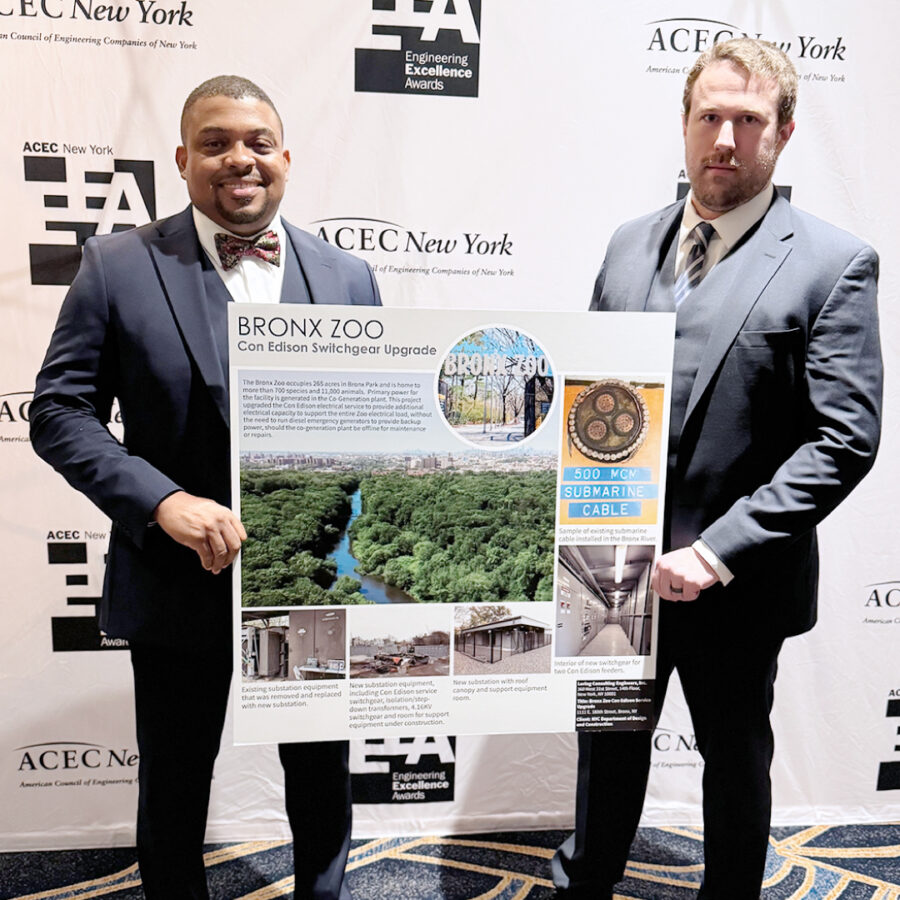
These awards reflect the dedication, collaboration, and innovation our team brings to every project. Congratulations to everyone who made these achievements possible!
Fire Protection + Life Safety Engineering
At Loring, our Fire Protection and Life Safety engineers are experienced professionals with the expertise needed to engineer systems that protect both human life and property. The design of Fire Alarm, Emergency Notification, Fire Suppression, Fire Extinguishing and Smoke Management Systems requires in-depth knowledge of code requirements, familiarity with available system technologies, and the ability to engineer systems in response to each Owner’s unique requirements for their building. Most importantly, Loring understands how each of these stand-alone Life Safety systems can and should be integrated into an overall comprehensive fire protection strategy for a building. Listed below are brief descriptions of how Loring’s Fire Protection +Life Safety engineers can help with the design of your next project.
Fire Alarm Systems
Loring’s team of NICET-certified Level II, III and IV engineers have the special knowledge required to properly design fire alarm systems for virtually every type of building. We are particularly experienced in the replacement of antiquated fire alarm systems within existing, fully occupied buildings. Beyond minimum code requirements, our engineers are well versed with the requirements of local Authorities Having Jurisdiction (AHJ’s), including navigating the complexities of the rules and regulations of the Fire Department of New York (FDNY). Fire Alarm System designs include:
- Multiplexed, Addressable systems
- Voice Communication Systems
- Very Early Smoke Detection (VESDA) Systems

Emergency Evacuation Systems
In times of crisis, it is imperative that effective, reliable communications systems are in place to allow sharing of critical information between firefighters, as well as between the Fire Safety Director and building occupants. Loring designs these systems as part of a comprehensive Fire Protection Plan. Examples of these communication systems include:
- Auxiliary Radio Communication System (ARCS)
- Emergency Radio Communication System (ERCS)
- Distributed Antennae Systems (DAS)
- Mass Notification Systems
Distributed Antennae System Schematic

Fire Suppression Systems
The engineering of conventional water-based sprinkler and standpipe systems is a critical component of any fire protection solution and is suitable for many applications. In addition to full wet system coverage, Loring’s engineers can assist with variations that may be suitable to specialty areas where water dispersion could cause serious damage or safety concerns such as electrical and communications equipment rooms, or rooms subject to freezing including loading docks, generator rooms, or open parking garages. Examples of these specialty solutions include:
- Dry Pipe Systems
- Pre-Action Systems
- Deluge Systems

Fire Extinguishing Systems
When conventional water-based fire suppression systems are not appropriate for specialty applications or high-value spaces, Loring’s engineers are proficient in designing gaseous clean agent or foam extinguishing systems to extinguish the fire without damaging the contents of the room. Specific applications include:
- Data Centers
- Museums
- Archival Storage
- Fuel Dispensaries

Smoke Management Systems
The proper design of both positive pressurization and exhaust systems to manage the movement of air during and after a fire event is of paramount importance, allowing for the safe evacuation of occupants during a smoke event, as well as returning the building to normal operations with minimum disruption. These systems include:
- Smoke Control
- Stair Pressurization
- Post Fire Smoke Purge

Life Safety Documentation
Many codes require that facilities have well-documented plans for emergency response to a smoke/fire condition. Loring has significant experience preparing these plans and other documentation to assist building Owner’s in meeting both code requirements and internal objectives as part of their comprehensive Fire Safety strategy.
- Fire Safety Plans
- Fire Evacuation Plans
- As-Buit conditions

Compliance with Code Mandates
Many jurisdictions now require that existing buildings meeting certain criteria be retrofitted to be fully sprinklered. Loring’s fire protection engineers can assist Owners to comply with this requirement by analyzing the existing fire protection system infrastructure (if any) to determine the most cost-effective solution to provide full coverage sprinkler protection for the building.
Get In Touch

For more information on how Loring can help you with your Fire Protection + Life Safety challenges, contact
Jonatan Sabogal, PE, CFPS, NICET
Vice President – Life Safety Systems
Phone: 646-674-6100
Email:
jsabogal@loringengineers.com Loring’s Healthcare Group Engages in Key Industry Discussions on Healthcare Construction and
Facility Management
Loring’s Healthcare Group recently participated in two significant industry events, Healthcare Group Leader,
Rahul Tikekar, PE, MS, MBA, shared his expertise on critical topics shaping the future of healthcare facilities.
National Healthcare Construction Forum - March 18, 2025
Hosted by Commercial Observer, the National Healthcare Construction Forum brought together industry leaders to discuss emerging trends in healthcare construction and design. Rahul had the pleasure of moderating a dynamic panel focused on Energy Innovations, Electrification, and Resiliency in Healthcare Facilities. The discussion explored cutting-edge strategies for improving energy efficiency, integrating sustainable solutions, and ensuring the long-term resilience of healthcare infrastructure.
Healthcare Facilities Management Society of New Jersey - March 20, 2025
Just days later, Rahul along with Vice President Charlies Lesniak presented at the Healthcare Facilities Management Society of New Jersey (HFMSNJ) event, where he delved into the evolving design of operating and procedure rooms. His session highlighted the critical integration of MEP systems and imaging equipment, emphasizing the importance of seamless coordination between engineering and medical technology for optimal patient care and operational efficiency.
These events provided an excellent opportunity for Loring to engage with industry peers, share insights, and contribute to conversations on the future of healthcare facility design and construction.
Stay tuned for more updates, and check out some highlights from these events in the images below!
 National Healthcare Construction Forum
National Healthcare Construction Forum
 Healthcare Facilities Management Society of New Jersey
Healthcare Facilities Management Society of New JerseyWe are pleased to announce the promotion of Avash Joshi, P.Eng, to lead our Toronto Office
Avash Joshi began his professional career at Loring as an intern in 2012 while completing his Bachelor of Science and Master of Engineering degrees from Rochester Institute of Technology. He joined Loring full-time in 2013, in Loring’s Commissioning and Energy Services Group where he gained significant experience in commissioning, energy auditing, energy modeling, and Computational Fluid Dynamics (CFD) simulations. He is a Certified Energy Manager, Certified Building Commissioning Professional, and LEED Accredited Professional.
In 2016, Avash moved to Toronto from New York City. Despite his relatively short tenure with the firm, Loring recognized his talents and growth potential, and elected to open a Canadian office to enable Avash to continue his career at Loring while simultaneously expanding Loring’s geographical presence into Canada. Over the last nine years, Avash has contributed to Loring’s growth in Toronto while leading the mechanical engineering team to complete several high-profile design projects (such as the BAS replacement at Toronto City Hall and a new net-zero administration building for the Durham Region of Transit). He also leads Loring’s Canadian commissioning team, which has undertaken several laboratory and healthcare projects for the University of Toronto and the Sunnybrook Health Sciences Centre.
An excellent communicator and insightful leader in addition to his technical acumen, Avash was named Loring’s Mechanical Engineer of the Year in 2023. We are excited to announce that Avash has been promoted to Vice President and leader of Loring’s Toronto office, where he will be responsible for overseeing our Canadian operations. Please join us in congratulating Avash on this most recent career advancement. New Jersey Executive Statehouse Renovation and Restoration project honored with the
ACEC-NJ Grand Honor Award for
Non-Transportation Projects
Loring is proud to announce that
The New Jersey Executive Statehouse Renovation and Restoration project has been honored with the
Grand Honor Award for Non-Transportation Projects at the
ACEC-NJ Engineering Excellence Awards Banquet! Loring provided mechanical, electrical, plumbing, and telecom / AV engineering services for the project.
A special shoutout to
Vincent Farese, PE and Nitish Joy, PE, who proudly accepted the award on behalf of Loring.
This achievement is a testament to the dedication, creativity, and collaboration of our team. Successfully integrating modern mechanical and electrical systems while preserving the building’s historic integrity required innovative solutions and seamless coordination across disciplines.
A huge thank you to our project partners:
- Nelson Worldwide (Architecture)
- PDP (Preservation Architecture)
- Silman (Structural Engineering)
- Jensen Hughes (Fire Protection)
- Langan (Site/Civil)
- Gary Steffy Lighting Design (Lighting)
- SMW (Acoustics)
- Turner Construction Co. (Construction Management)
- Daniel J. Keating Co. (General Contractor)
We are also excited to share that this project has received a
National Recognition Award in
ACEC’s 2025 Engineering Excellence Awards competition! The achievement will be celebrated at a
gala dinner in Washington, DC on May 20, 2025

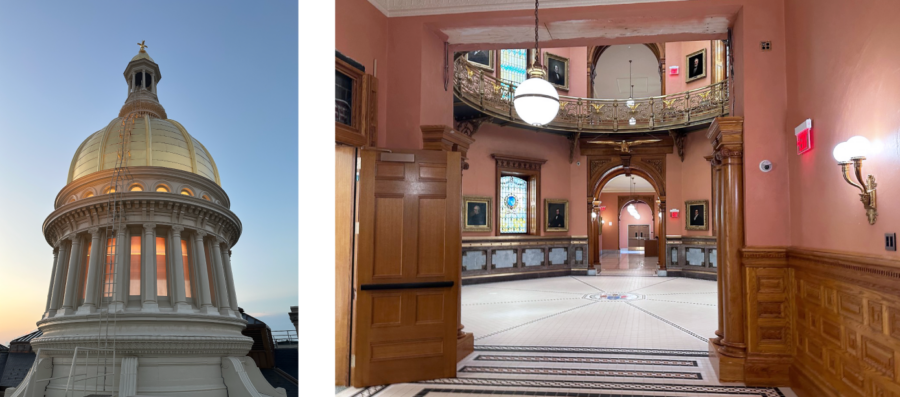
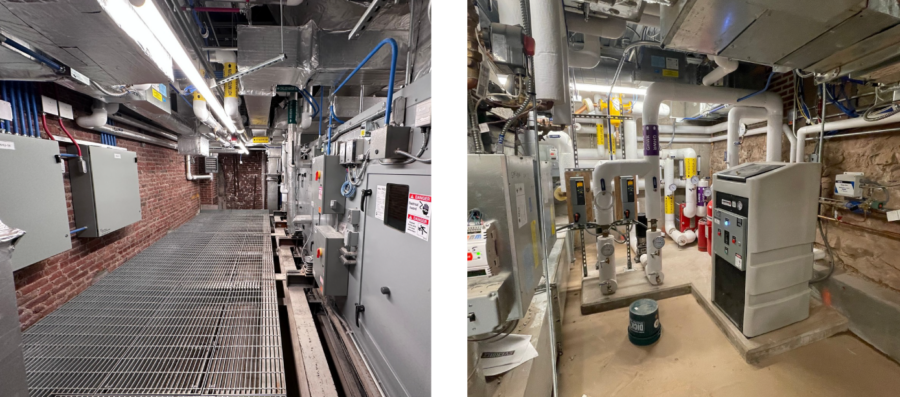
Building Simulation Services
At Loring, we leverage our extensive building systems expertise to integrate advanced simulation techniques into our design practice. Our commitment to innovation allows us to deliver optimized designs tailored to meet the unique requirements of each project.
We utilize a suite of sophisticated simulation tools to tackle complex engineering challenges, ensuring that our solutions are not only effective but also efficient. By combining our deep knowledge of building systems with cutting-edge technology, we develop solutions that align with our clients’ goals and project needs.
CFD Simulation
As part of our commitment to technical excellence and innovation, Loring has a dedicated team of specialist / modeling engineers who provide
Computational Fluid Dynamics (CFD) services. We work closely with design teams and clients to understand and realize unique project requirements.
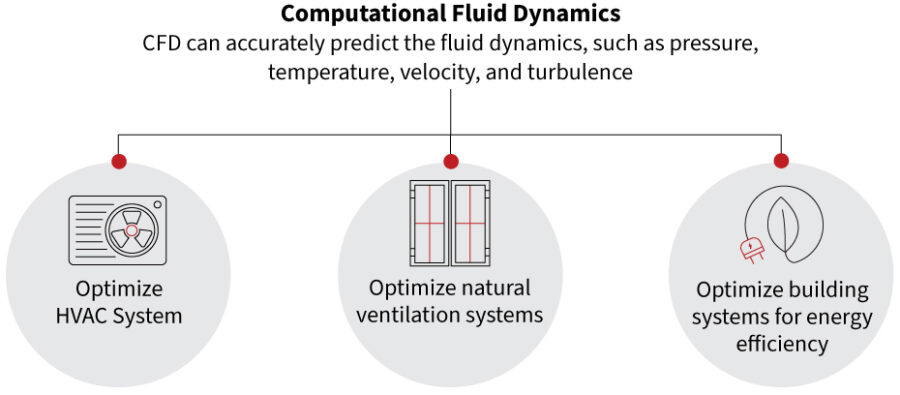
CFD plays an increasingly important role in designing thermally comfortable, healthy, and energy-efficient buildings. Its applications range from building site planning to individual room layout design, from active mechanical HVAC system design to passive ventilation studies, and from regular indoor air quality assessments to critical fire, smoke, and contaminant control.
Key CFD applications for buildings include:
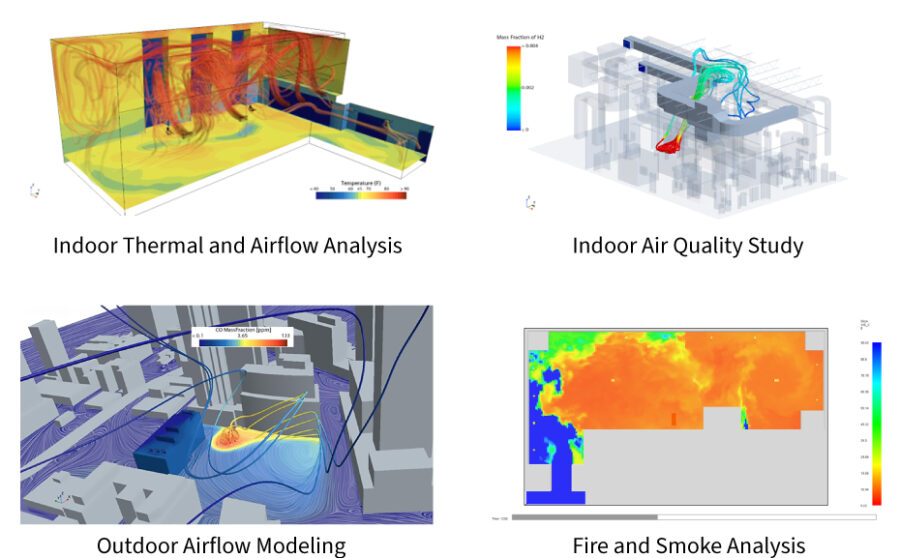 Indoor Thermal and Airflow Analysis
Indoor Thermal and Airflow Analysis
- Air distribution and ventilation system optimization
- Thermal comfort predictions for occupants
- Temperature and humidity distribution modeling
- Passive Ventilation Studies including natural ventilation and buoyancy-driven exhaust
Indoor Air Quality Study
- Evaluation of ventilation strategies and potential contaminant spread
- Airborne disease control
Outdoor Airflow Modeling
- Pedestrian wind comfort and safety assessment
- Urban microclimate studies
- Exterior Contaminant Dispersion
- Exhaust Re-entrainment
Fire and Smoke Analysis
- Smoke Movement and Dispersion
- Ventilation System Performance Evaluation
- Heat Transfer Analysis
Multizone Airflow Modeling

We utilize advanced multizone airflow modeling to perform comprehensive stack effect and smoke management studies. These analyses are crucial for ensuring the safety and efficiency of building ventilation systems, particularly in high-rise buildings and complex structures.
Stack Effect Analysis
- Understanding Air Movement: Analyze the natural movement of air within buildings due to temperature differences between indoor and outdoor environments.
- Pressure Differential Management: Evaluate and manage pressure differentials across different building zones to prevent unwanted airflow and ensure balanced ventilation.
- Design Optimization: Optimize building designs to mitigate negative impacts of stack effect, such as drafts, energy loss, and compromised indoor air quality.
Smoke Management Studies
- Smoke Movement and Dispersion: Simulate the movement and dispersion of smoke within a building
- Stairwell and Elevator Pressurization: Design and optimize pressurization systems for stairwells and elevator shafts to create positive pressure differentials, preventing smoke infiltration and ensuring safe evacuation routes.
Fluid Network Analysis
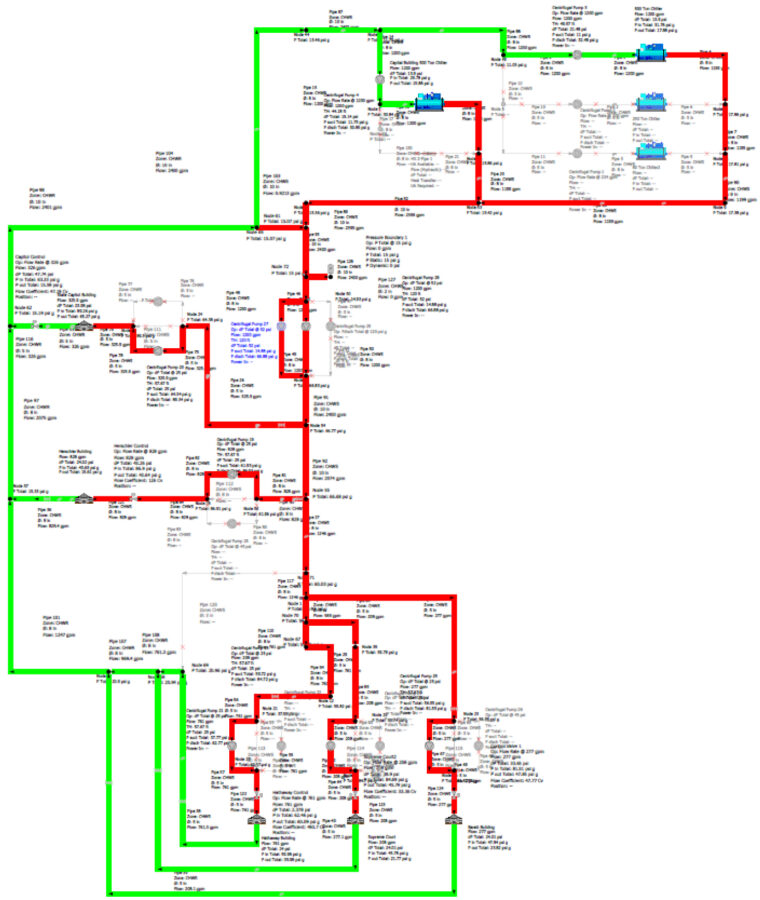
We use advanced simulation tools to design and optimize fluid networks, ensuring efficient and reliable operation. Our simulations predict system behavior under various conditions, allowing for precise adjustments and improvements. Our expertise ensures optimal performance, energy efficiency, and reliability for your HVAC, plumbing, and fire protection systems.
Hydronic System Performance
- Pipe sizing and pressure drop analysis for optimal flow distribution
- Pump optimization for energy efficiency and load adaptability
Thermal and Domestic Water Systems
- Hot and chilled water distribution modeling to minimize energy losses
- Water supply and drainage analysis to maintain pressure balance and prevent backflow
Fire Protection System Optimization
- Hydraulic calculations for sprinkler, standpipe, and hydrant systems
- Simulations for emergency flow conditions and suppression effectiveness
Energy Modeling

At Loring, we leverage whole building energy simulations to provide comprehensive assessments of a building’s energy consumption. These advanced simulations allow our designers to evaluate different scenarios, compare the energy performance of various design alternatives, and select the most efficient solutions.
Design Optimization
- Comparison of different mechanical systems and energy conservation strategies
- Optimization of system sizing to avoid over-designing
Performance Analysis
- Estimation of building thermal loads and energy use
- Calculation of energy costs and potential savings
Compliance and Certification
- Support for code compliance demonstrations
- Assistance in achieving green building certifications like LEED
- Qualification for tax credits and utility incentives
Sustainability Initiatives
- Support for building decarbonization efforts
- Evaluation of renewable energy integration
Get In Touch
 To find out how Building Simulation Services can assist you with your project needs, please contact Maria Xia, Vice President of Building Simulation Services
To find out how Building Simulation Services can assist you with your project needs, please contact Maria Xia, Vice President of Building Simulation Services
Phone: 646-674-6151
Email: mxia@loringengineers.com
LORING ANNOUNCES 2025 PROMOTIONS
We are pleased to announce...
Charles Lesniak, PE and Peter Morin, PE have been elevated to Vice Presidents.
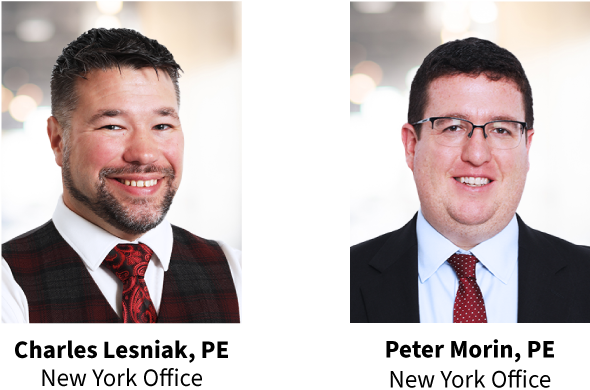
Michael Minzicu, PE, Andrew J. Silvestre, PE, Pawel Tryzna and Eric Wells have been elevated to Associate Vice Presidents.

More Advancements
Andrew Franceschina, PE
, Thomas Irkinas
, Gregory Johnson and Wai Ng, PE
have been elevated to Senior Associate.

Recently named Associates are: Maggie Lei, EIT, Nicholas Martella and Shreyas Modi, PE.
 Akia Izaguirre has been elevated to Senior Marketing and Proposal Manager.
Akia Izaguirre has been elevated to Senior Marketing and Proposal Manager.
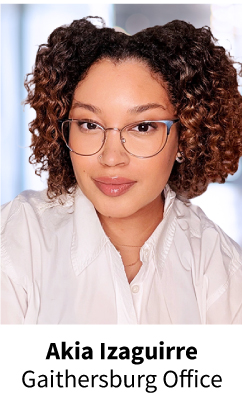
Please join us in congratulating these extraordinary professionals on their latest career achievements!
Driving Sustainability: Loring's Expertise in Sustainable Design
As energy conservation and greenhouse gas emission reductions become critical priorities for our clients,
Loring Consulting Engineers is at the forefront with cutting-edge expertise in sustainable design and consulting. We focus on practical, high-impact solutions to ensure clients achieve measurable results that align with environmental goals and regulatory mandates. From enhancing energy efficiency to designing advanced renewable energy systems, Loring is committed to shaping a more sustainable future.
Energy Modeling
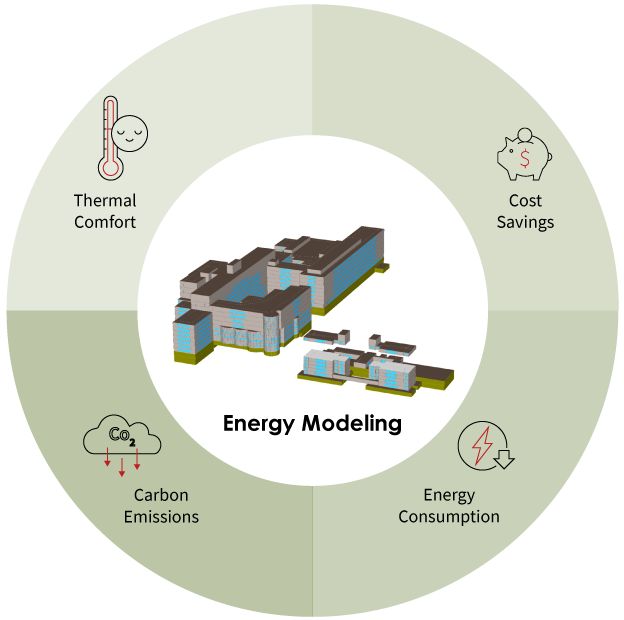
Energy modeling is a key tool in our sustainability practice, enabling us to evaluate design alternatives, optimize building performance, and comply with rigorous regulatory standards. At Loring, we leverage advanced simulation software to deliver precise analyses of energy consumption, carbon emissions, thermal comfort, and cost savings.
Our energy modeling expertise includes:
- Compliance Analysis: Ensuring alignment with energy performance requirements, including ASHRAE 90.1 and LEED.
- Design Optimization: Supporting owners and architects in achieving energy-efficient designs through iterative simulations of HVAC systems, envelope performance, and lighting strategies.
- Incentive Programs: Helping clients secure financial incentives through programs such as NYSERDA’s Commercial New Construction Program and utility-sponsored energy-efficiency rebates.
- Net-Zero Pathways: Developing realistic plans for achieving net-zero energy and carbon emissions through renewable energy integration and load reduction strategies.
Our energy modeling services are designed to align with project goals, whether focused on compliance, cost savings, or long-term sustainability objectives.
LEED Consulting Services

At Loring, we provide comprehensive sustainability consulting services aligned with the LEED rating system, supporting clients from the pre-schematic phase through construction administration. LEED (Leadership in Energy and Environmental Design) is a globally recognized green building certification program, with rating systems tailored to different project types, including Building Design and Construction (BD+C) for new construction and major renovations, and Interior Design and Construction (ID+C) for interior fit-out projects.
When clients opt for LEED certification, Loring serves as a trusted partner, coordinating with all trades to ensure compliance with LEED standards throughout the design and construction phases. Our expertise helps projects achieve certification at one of four levels:
Certified,
Silver,
Gold, or
Platinum. We focus on key strategies such as:
- Sustainable Site Solutions: Minimizing environmental impact with strategies like solar-reflective roofing, stormwater management, and optimized exterior lighting.
- Water Efficiency: Implementing innovative conservation strategies and submetering systems.
- Energy Efficiency: Designing efficient HVAC systems and optimizing energy submetering to meet or exceed energy benchmarks.
- Material and Resource Management: Specifying sustainable materials and facilitating recycling practices during operations.
- Indoor Environmental Quality: Enhancing occupant comfort with low-VOC materials, thermal comfort, lighting optimization, and access to quality outdoor views.
For example, Loring has successfully managed projects in New York City requiring LEED Gold certification or higher to comply with
Local Law 51 of 2023, as well as public school projects meeting the
NYC Green Schools Guide standards.
As the industry evolves, Loring remains at the forefront of sustainable design through ongoing research and training, including preparation for LEED v5, which emphasizes
Decarbonization,
Quality of Life, and
Ecological Conservation and Restoration.
In addition to LEED consulting, our multidisciplinary teams enhance project outcomes through complementary services such as Commissioning. Loring's dedicated
Commissioning Group provides expertise in Fundamental Commissioning and Verification, as well as Enhanced Commissioning credits, ensuring that building systems are designed, installed, and functioning as intended to meet energy and performance goals. These services play a crucial role in ensuring that projects achieve optimal energy efficiency and performance.
Electric Vehicle Charging Design
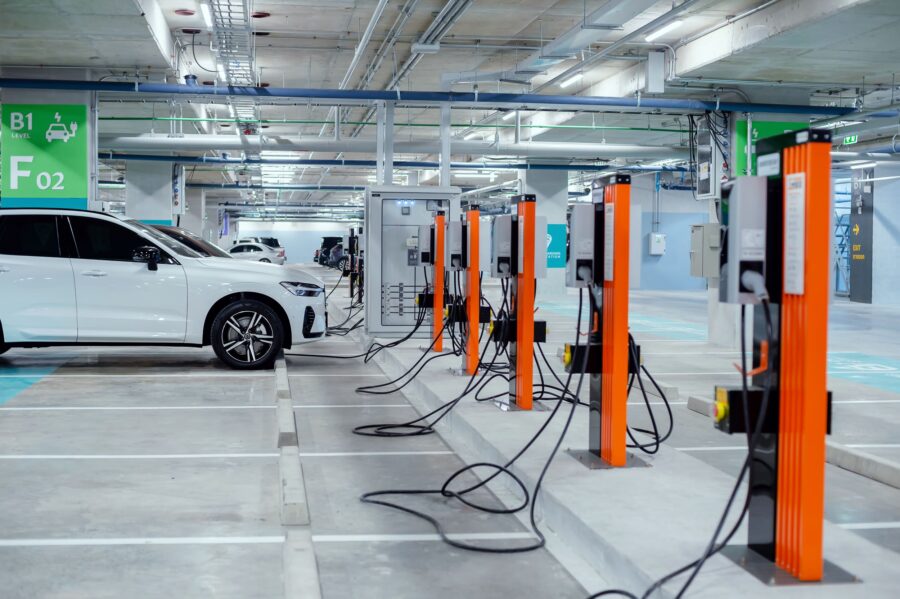
With the growing adoption of electric vehicles (EVs), the need for efficient, scalable, and sustainable EV charging infrastructure is rising. Loring specializes in designing EV charging stations tailored to meet the specific needs of each project.
We assist in ensuring new and existing parking garages and lots comply with regulations like New York City’s Local Law 55 (LL55), which mandates the installation of EV charging stations in garages and parking lots with 10 or more spaces. Our designs ensure compliance with the LL55 deadline of 2035, preparing systems for future growth.
Key considerations in EV charging station design include:
- Location: Strategically positioning chargers to maximize accessibility and traffic flow.
- Power Supply & Load Management: Ensuring reliable power with appropriate grid connections and smart load-balancing systems.
- Scalability: Designing systems to accommodate future demand and evolving technologies.
PV Solar Design

Loring designs photovoltaic (PV) solar systems to help clients achieve energy independence, reduce costs, and minimize environmental impact. Whether transitioning to renewable energy or enhancing green initiatives, our PV solutions are customized to meet specific energy needs.
The benefits of solar energy include:
- Cost Efficiency: Long-term savings through reduced energy consumption.
- Sustainability: Lower carbon footprint and environmental impact.
- Reliability: Consistent energy generation with optional backup systems.
- Versatility: Scalable solutions for residential, commercial, and industrial applications.
We conduct thorough feasibility assessments, including evaluations of the electrical distribution system, roof space, and structural integrity. Our team works with structural engineers to ensure the roof can support the system.
Battery Energy Storage Solutions
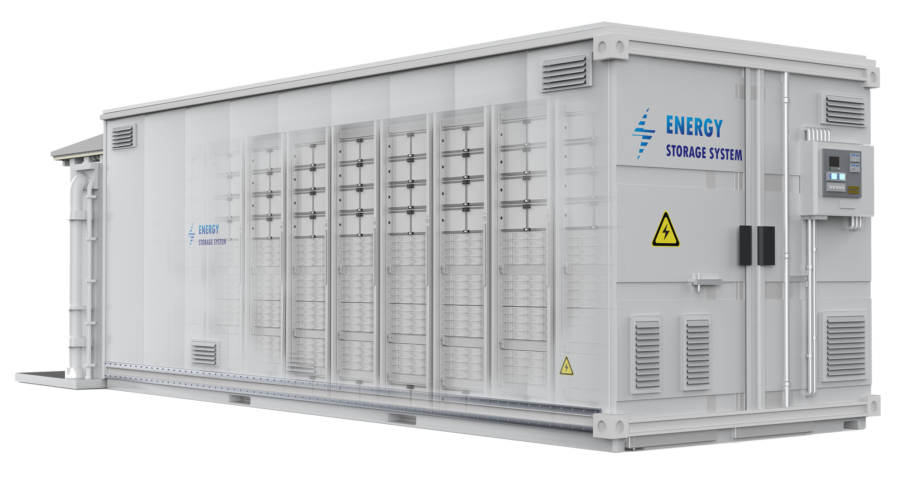
As renewable energy adoption grows, battery energy storage systems (BESS) are essential for ensuring consistent power supply and grid stability. Loring specializes in designing efficient and scalable BESS solutions tailored to your project's unique needs. Our services include feasibility studies and electrical load calculations, ensuring that every solution is practical and aligned with project goals. With extensive knowledge of the regulatory landscape surrounding battery storage, we guide clients through compliance requirements with confidence.
When analyzing buildings for solar PV feasibility, we often recommend battery storage as an additional feature to optimize energy generation and consumption. Key benefits of BESS include:
- Cost Savings: Store electricity during low-demand periods and use it during peak periods to minimize demand charges.
- Enhanced Reliability: Provide uninterrupted power during outages.
- Renewable Integration: Capture and store excess energy for later use.
Summary
At Loring Consulting Engineers, we are committed to leading the way in sustainable design by delivering innovative solutions that not only meet but exceed regulatory standards. Our comprehensive approach – spanning energy modeling, LEED certification, commissioning, renewable energy systems, and infrastructure design – ensures that every project achieves exceptional energy efficiency and long-term sustainability. By applying cutting-edge technologies and strategies, we help our clients reduce their environmental footprint while maximizing value. Together, we are driving the transition toward a greener, more resilient future for generations to come.
Contact Information
Kalpak Karule is a Principal and
Edgar Arevalo is an Associate in the New York office.

2024 Employee Recognition Awards and Project of the Year Award
J. Michael Galway named 2024 Mechanical Engineer of the Year by Plumbing & Mechanical
We're thrilled to announce that our very own J. Michael Galway, PE, LEED AP, CPD has been named 2024 Mechanical Engineer of the Year by Plumbing & Mechanical! This prestigious honor is a testament to Michael's dedication, expertise, and the lasting impact he's made in our industry.
At Loring, Michael’s innovative approach and leadership have driven remarkable results, setting the standard in mechanical engineering. This award shines a spotlight on his commitment to excellence and to the values we all hold high at Loring. Congratulations, Michael, on this well-deserved recognition!
Here's a link to the full article:
 Gold Award
Bronx Zoo – Con Edison Switchgear Upgrade
A project dedicated to enhancing resilience and reliability at one of New York's most iconic destinations.
Gold Award
Bronx Zoo – Con Edison Switchgear Upgrade
A project dedicated to enhancing resilience and reliability at one of New York's most iconic destinations.
 These awards reflect the dedication, collaboration, and innovation our team brings to every project. Congratulations to everyone who made these achievements possible!
These awards reflect the dedication, collaboration, and innovation our team brings to every project. Congratulations to everyone who made these achievements possible!






 For more information on how Loring can help you with your Fire Protection + Life Safety challenges, contact
For more information on how Loring can help you with your Fire Protection + Life Safety challenges, contact




 CFD plays an increasingly important role in designing thermally comfortable, healthy, and energy-efficient buildings. Its applications range from building site planning to individual room layout design, from active mechanical HVAC system design to passive ventilation studies, and from regular indoor air quality assessments to critical fire, smoke, and contaminant control.
Key CFD applications for buildings include:
CFD plays an increasingly important role in designing thermally comfortable, healthy, and energy-efficient buildings. Its applications range from building site planning to individual room layout design, from active mechanical HVAC system design to passive ventilation studies, and from regular indoor air quality assessments to critical fire, smoke, and contaminant control.
Key CFD applications for buildings include:
 Indoor Thermal and Airflow Analysis
Indoor Thermal and Airflow Analysis
 We utilize advanced multizone airflow modeling to perform comprehensive stack effect and smoke management studies. These analyses are crucial for ensuring the safety and efficiency of building ventilation systems, particularly in high-rise buildings and complex structures.
Stack Effect Analysis
We utilize advanced multizone airflow modeling to perform comprehensive stack effect and smoke management studies. These analyses are crucial for ensuring the safety and efficiency of building ventilation systems, particularly in high-rise buildings and complex structures.
Stack Effect Analysis
 We use advanced simulation tools to design and optimize fluid networks, ensuring efficient and reliable operation. Our simulations predict system behavior under various conditions, allowing for precise adjustments and improvements. Our expertise ensures optimal performance, energy efficiency, and reliability for your HVAC, plumbing, and fire protection systems.
Hydronic System Performance
We use advanced simulation tools to design and optimize fluid networks, ensuring efficient and reliable operation. Our simulations predict system behavior under various conditions, allowing for precise adjustments and improvements. Our expertise ensures optimal performance, energy efficiency, and reliability for your HVAC, plumbing, and fire protection systems.
Hydronic System Performance
 At Loring, we leverage whole building energy simulations to provide comprehensive assessments of a building’s energy consumption. These advanced simulations allow our designers to evaluate different scenarios, compare the energy performance of various design alternatives, and select the most efficient solutions.
Design Optimization
At Loring, we leverage whole building energy simulations to provide comprehensive assessments of a building’s energy consumption. These advanced simulations allow our designers to evaluate different scenarios, compare the energy performance of various design alternatives, and select the most efficient solutions.
Design Optimization



 Recently named Associates are: Maggie Lei, EIT, Nicholas Martella and Shreyas Modi, PE.
Recently named Associates are: Maggie Lei, EIT, Nicholas Martella and Shreyas Modi, PE.


 Energy modeling is a key tool in our sustainability practice, enabling us to evaluate design alternatives, optimize building performance, and comply with rigorous regulatory standards. At Loring, we leverage advanced simulation software to deliver precise analyses of energy consumption, carbon emissions, thermal comfort, and cost savings.
Our energy modeling expertise includes:
Energy modeling is a key tool in our sustainability practice, enabling us to evaluate design alternatives, optimize building performance, and comply with rigorous regulatory standards. At Loring, we leverage advanced simulation software to deliver precise analyses of energy consumption, carbon emissions, thermal comfort, and cost savings.
Our energy modeling expertise includes:
 At Loring, we provide comprehensive sustainability consulting services aligned with the LEED rating system, supporting clients from the pre-schematic phase through construction administration. LEED (Leadership in Energy and Environmental Design) is a globally recognized green building certification program, with rating systems tailored to different project types, including Building Design and Construction (BD+C) for new construction and major renovations, and Interior Design and Construction (ID+C) for interior fit-out projects.
When clients opt for LEED certification, Loring serves as a trusted partner, coordinating with all trades to ensure compliance with LEED standards throughout the design and construction phases. Our expertise helps projects achieve certification at one of four levels: Certified, Silver, Gold, or Platinum. We focus on key strategies such as:
At Loring, we provide comprehensive sustainability consulting services aligned with the LEED rating system, supporting clients from the pre-schematic phase through construction administration. LEED (Leadership in Energy and Environmental Design) is a globally recognized green building certification program, with rating systems tailored to different project types, including Building Design and Construction (BD+C) for new construction and major renovations, and Interior Design and Construction (ID+C) for interior fit-out projects.
When clients opt for LEED certification, Loring serves as a trusted partner, coordinating with all trades to ensure compliance with LEED standards throughout the design and construction phases. Our expertise helps projects achieve certification at one of four levels: Certified, Silver, Gold, or Platinum. We focus on key strategies such as:
 With the growing adoption of electric vehicles (EVs), the need for efficient, scalable, and sustainable EV charging infrastructure is rising. Loring specializes in designing EV charging stations tailored to meet the specific needs of each project.
We assist in ensuring new and existing parking garages and lots comply with regulations like New York City’s Local Law 55 (LL55), which mandates the installation of EV charging stations in garages and parking lots with 10 or more spaces. Our designs ensure compliance with the LL55 deadline of 2035, preparing systems for future growth.
Key considerations in EV charging station design include:
With the growing adoption of electric vehicles (EVs), the need for efficient, scalable, and sustainable EV charging infrastructure is rising. Loring specializes in designing EV charging stations tailored to meet the specific needs of each project.
We assist in ensuring new and existing parking garages and lots comply with regulations like New York City’s Local Law 55 (LL55), which mandates the installation of EV charging stations in garages and parking lots with 10 or more spaces. Our designs ensure compliance with the LL55 deadline of 2035, preparing systems for future growth.
Key considerations in EV charging station design include:
 Loring designs photovoltaic (PV) solar systems to help clients achieve energy independence, reduce costs, and minimize environmental impact. Whether transitioning to renewable energy or enhancing green initiatives, our PV solutions are customized to meet specific energy needs.
The benefits of solar energy include:
Loring designs photovoltaic (PV) solar systems to help clients achieve energy independence, reduce costs, and minimize environmental impact. Whether transitioning to renewable energy or enhancing green initiatives, our PV solutions are customized to meet specific energy needs.
The benefits of solar energy include:
 As renewable energy adoption grows, battery energy storage systems (BESS) are essential for ensuring consistent power supply and grid stability. Loring specializes in designing efficient and scalable BESS solutions tailored to your project's unique needs. Our services include feasibility studies and electrical load calculations, ensuring that every solution is practical and aligned with project goals. With extensive knowledge of the regulatory landscape surrounding battery storage, we guide clients through compliance requirements with confidence.
When analyzing buildings for solar PV feasibility, we often recommend battery storage as an additional feature to optimize energy generation and consumption. Key benefits of BESS include:
As renewable energy adoption grows, battery energy storage systems (BESS) are essential for ensuring consistent power supply and grid stability. Loring specializes in designing efficient and scalable BESS solutions tailored to your project's unique needs. Our services include feasibility studies and electrical load calculations, ensuring that every solution is practical and aligned with project goals. With extensive knowledge of the regulatory landscape surrounding battery storage, we guide clients through compliance requirements with confidence.
When analyzing buildings for solar PV feasibility, we often recommend battery storage as an additional feature to optimize energy generation and consumption. Key benefits of BESS include:










